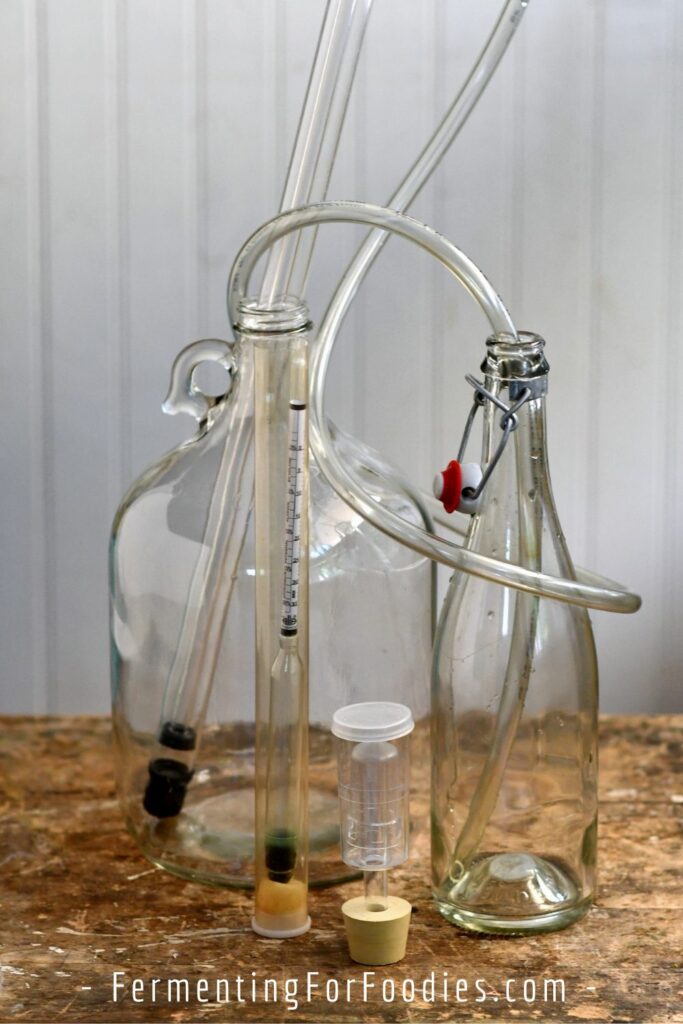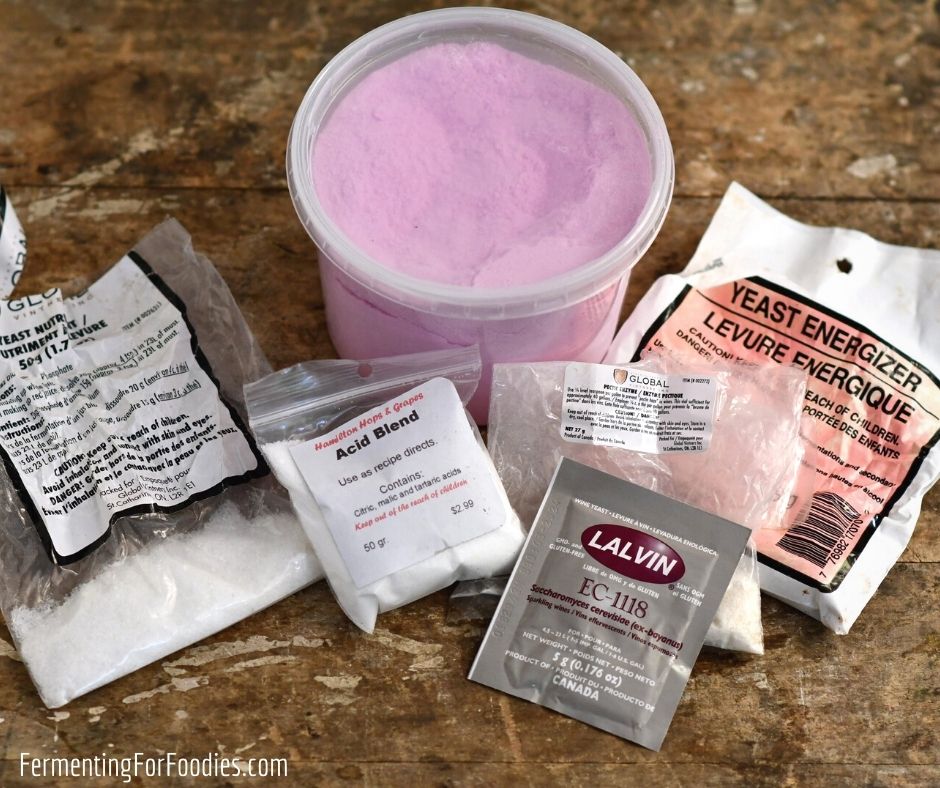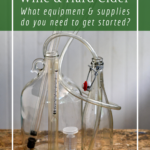It is cheap and easy to make cider and wine at home. Here is a list of the wine making supplies and equipment needed for making wine at home.

Beyond a large vessel to ferment in, there really isn’t any specialized equipment required to turn fruit into cider or wine. Like most forms of fermentation, it is one of those things that happens naturally. This is why people have been making cider and wine for centuries!
However, investing in a few specialized cider and wine making supplies will ensure that the final beverage tastes good.
Note: This post contains sponsored links. This is an arrangement between Fermenting For Foodies and the supplier, and readers never pay more for a product. Thank you for your support!
This post on winemaking supplies is part of a larger series of posts on cider and wine. Check out Everything You Need to Know about Making Cider and Wine to learn more.
Cider and Wine Making Supplies
To properly make wine, you need all of these pieces of equipment. Luckily, it’s easy to find everything you need at your local homebrew store or online. Best of all, you should be able to buy all of this equipment for less than $50.
- Airlock: An airlock allows carbon dioxide to escape while maintaining a sterile fermenting environment. I recommend cylindrical airlocks because they are easier to clean than S-shaped airlocks. They cost about $2 each and come with different sized bungs. Just make to buy one that fits snugly into the mouth of your carboy.
- Carboy: The carboy is a large container that is used for secondary fermentation. In my case, I use 5-gallon jugs that I get from buying apple juice. If you want to make large batches of wine you can invest in large carboys.
- Siphon and Tubes: Food-grade tubes and an auto-siphon are used for moving liquid between vessels. They are also handy for filtering out sediment during racking and bottling. They only cost $20 and are well worth the investment.
- Sanitation Chemicals: It’s important to sanitize all equipment to prevent contamination from unwanted yeasts, bacteria, and mold. Sanitizing equipment is the best way to make sure your wine is safe and delicious.
- Hydrometer: A hydrometer measures the approximate alcohol levels of your wine. It can help you determine when your wine has finished fermenting and is ready for bottling. It is the only piece of equipment that is not strictly necessary, however, it is pretty handy!
Cider and Wine Making Ingredients
All wine starts with two simple ingredients:
- Fruit: Grapes happen to have all the sugars, protein, and tannin required to feed the yeast and make wine. This is why grape-based wines are so common. However, any fruit or juice will ferment into wine. However, they won’t become very alcoholic without a bit of extra help. See the section below if you plan on making fruit wine.
- Yeasts: Historically, all alcohol was made with wild yeasts. However, wild yeasts tend to die out at 5% ABV, so they aren’t ideal for stronger beverages. Over time, specific strains of yeast were cultivated to make white wine, champagne, etc. The yeasts were selected to ferment at particular temperatures and will influence the flavor of the end product. You can buy various strains of yeasts online or at your local brewing and wine-making shops.
Optional Additives
As I mentioned above, cider and wine are made of two things: fruit and yeast. However, there are a few additional ingredients that are handy if you are making fruit wine.

- Acid blend: This is a combination of citric acid, malic acid, and tartaric acid. It is added to wine to raise acidity levels and improves the flavor of wine. Some recipes use freshly squeezed lemon juice instead, but acid blend is helpful if you need to add a lot of extra acidity.
- Yeast nutrient: This gives the yeast the nutrients, vitamins, and minerals needed to ensure a good ferment. It’s particularly useful when making wine from fruit, like pears, which don’t contain all the necessary nutrients.
- Yeast energizer: Yeast energizer will kick-start a sluggish ferment. It’s generally added to the secondary ferment.
- Campden Tablets: This is the most common form of sulfite used in cider and winemaking. It is added to the fruit before fermenting to kill any wild yeasts and molds. It is also used to halt fermentation at a particular alcohol level. Since I am sensitive to sulfites, so I don’t use it in any of my recipes.
Chemical Tests
There are a number of chemical tests that can be used for winemaking. They allow precision at every level of the process. You can test:
- fruit ripeness
- total acidity
- the pH of the finished wine
- oxidation
In general, these are not required for the home winemaker. Particularly, if you are only making small batches of wine for your own consumption.
Also, be careful with inexpensive chemical tests… their accuracy is pretty bad. For example, pH test strips vary widely in their accuracy and shouldn’t be used for winemaking.


Dear Admin(s)
Would be appreciated if help me for producing the white wine from grapes. I’m in Iran and I have access to kind of grapes.
I need the method(s) of making white wine by yeast and without yeast also.
Should be mentioned I have experienced in making red wine without any yeast as naturally and as traditional.
Thanks you
Farid
Hi Farid,
Typically white wines are made from just the juice of white grapes. If you make wine with the whole white grapes you will have an amber coloured wine.
I personally haven’t made wine with white grapes, however, the process should be similar to red wine. I would try using the same recipe and make a skin on “orange wine”. Alternatively, you can juice the grapes and use the juice to make a clear white wine.
Good luck! Emillie
quick question- what size bung do those applejuice jugs take??
Mine use #6, it’s 1.25″ across the top of the bung. Hope that helps!
yes! thank you